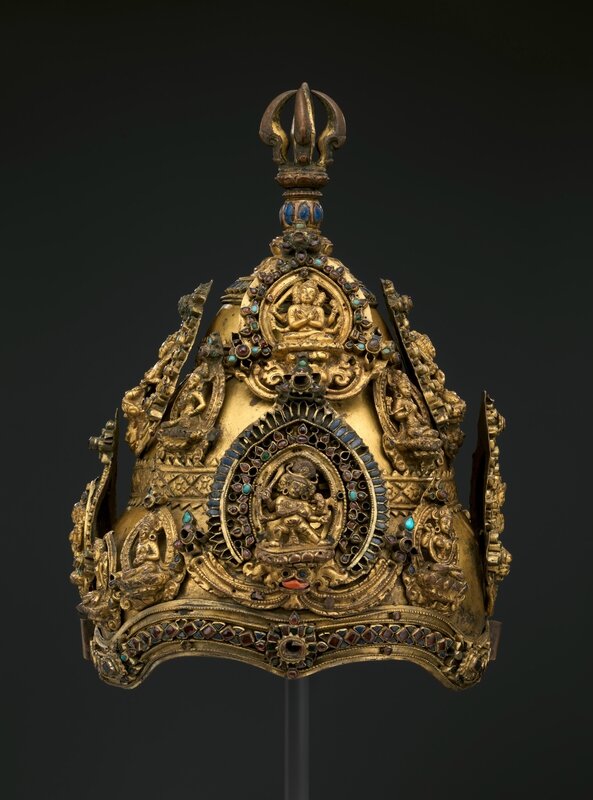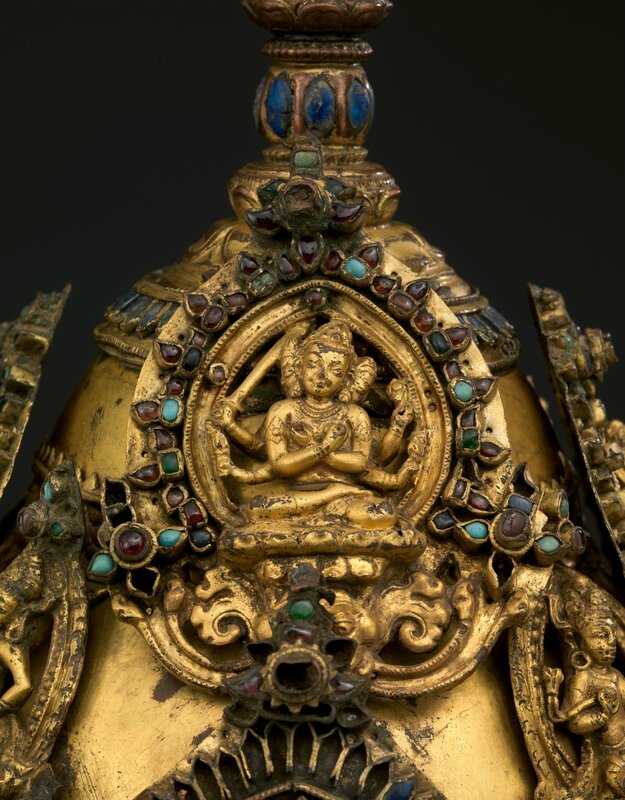Nepalese ritual crown donated to The Met by Barbara Levy Kipper
Vajracarya's Ritual Crown. Nepal, Kathmandu Valley. Early Malla period, 13th century. Gilt-copper alloy inlaid with semiprecious stones. The Metropolitan Museum of Art, Gift of Barbara and David Kipper, 2016. © 2000–2016 The Metropolitan Museum of Art.
NEW YORK, NY.- Thomas P. Campbell, Director and CEO of The Metropolitan Museum of Art, announced today that collector Barbara Levy Kipper has donated to the Museum an extraordinarily rare Nepalese ritual crown in gilt copper, dating from the late 13th or 14th century. Such crowns are worn by Nepalese Vajracarya priests who perform Vajrayana Buddhist ceremonies on behalf of devotees.
Mr. Campbell said, "Thanks to the generosity of Barbara Levy Kipper and her late husband David, this exceptionally early Esoteric Buddhist ritual object is now a centerpiece of The Met's holdings of Nepalese art. The crown will greatly enrich our display of South Asian art."
John Guy, the Museum's Florence and Herbert Irving Curator of the Arts of South and Southeast Asia, added: "This gift from the Kippers demonstrates a very high standard of copper repoussé artistry, in which the Newari metal workers excelled. Very few elaborate ritual crowns, of such early date and in such remarkable condition, have survived to this day."
Mrs. Kipper stated, "I am pleased that the crown is now reunited at The Met with other significant objects that were once part of the Zimmerman Family Collection."
Vajracarya's Ritual Crown, detail. Nepal, Kathmandu Valley. Early Malla period, 13th century. Gilt-copper alloy inlaid with semiprecious stones. The Metropolitan Museum of Art, Gift of Barbara and David Kipper, 2016. © 2000–2016 The Metropolitan Museum of Art.
The hereditary Vajracarya Buddhist priests of Nepal, who would have worn such a magnificently crafted crown, occupy the highest rank in the Nepalese Buddhist community. They serve as the officiating ritual agents of Vajrayana Buddhism as practiced in Nepal. The term Vajracarya denotes a person of high caste belonging to a family lineage entitled to perform priestly functions, including the Fire Sacrifice. Only the sons of Vajracaryas are admitted as Vajra-masters, entitling them to perform reserved priestly functions for others. These are analogous to the privileges held by Brahmins in Hinduism, who also enjoy hereditary and exclusive rights over ritual service.
This crown is exceptional in its complexity: it is dominated by a series of diadem plaques depicting emanations of the Bodhisattva of Transcendent Wisdom, Manjushri, in his esoteric form as Manjuvajra. Four wrathful and four benign medallions of Manjuvajra adorn the crown, supported by smaller plaques depicting goddesses presenting garlands and other offerings. All are repousséd in copper alloy and mercury gilded. The framing enclosures of each figural medallion are inset with assorted precious and semi-precious gemstones, turquoise, rock crystal, coral, and glass.
Vajracarya's Ritual Crown, detail. Nepal, Kathmandu Valley. Early Malla period, 13th century. Gilt-copper alloy inlaid with semiprecious stones. The Metropolitan Museum of Art, Gift of Barbara and David Kipper, 2016. © 2000–2016 The Metropolitan Museum of Art.
The central location directly above the bejeweled diadem is a rarely depicted subject, the wrathful emanation of Manjuvajra standing in an aggressive posture (pratiylidha), with crossed hands on the chest (invoking union with his consort), and wielding a sword, a ritual wand (kathvanga), and other implements. He is four-armed and three-faced, with large discal earrings, and with flaming hair framed by entwined snakes. In total, this crown displays eight representations of the wrathful and transcendent Manjuvajra.
All is surmounted by a five-pronged thunderbolt scepter, or vajra. This unique iconography points to the crown being designed for enacting rites dedicated to invoking the wisdom bodhisattva Manjushri in his esoteric form.
The crown is now on view at The Met Fifth Avenue in Gallery 252.
Vajracarya's Ritual Crown, back. Nepal, Kathmandu Valley. Early Malla period, 13th century. Gilt-copper alloy inlaid with semiprecious stones. The Metropolitan Museum of Art, Gift of Barbara and David Kipper, 2016. © 2000–2016 The Metropolitan Museum of Art.

/https%3A%2F%2Fprofilepics.canalblog.com%2Fprofilepics%2F1%2F0%2F100183.jpg)
/https%3A%2F%2Fstorage.canalblog.com%2F03%2F02%2F119589%2F96711876_o.jpg)
/https%3A%2F%2Fstorage.canalblog.com%2F11%2F31%2F119589%2F94773502_o.jpg)
/https%3A%2F%2Fstorage.canalblog.com%2F20%2F83%2F119589%2F94772815_o.jpg)
/https%3A%2F%2Fstorage.canalblog.com%2F26%2F72%2F119589%2F75604929_o.jpg)
/https%3A%2F%2Fstorage.canalblog.com%2F59%2F60%2F119589%2F26458628_o.jpg)






/http%3A%2F%2Fstorage.canalblog.com%2F74%2F94%2F119589%2F128705688_o.jpg)
/http%3A%2F%2Fstorage.canalblog.com%2F56%2F88%2F119589%2F127649882_o.jpg)
/http%3A%2F%2Fstorage.canalblog.com%2F41%2F75%2F119589%2F126978834_o.jpg)
/http%3A%2F%2Fstorage.canalblog.com%2F08%2F51%2F119589%2F126856859_o.jpg)